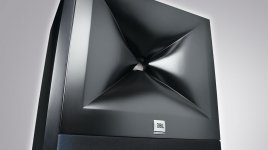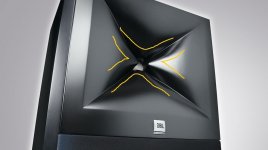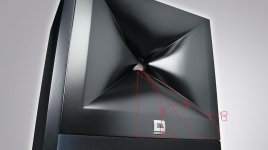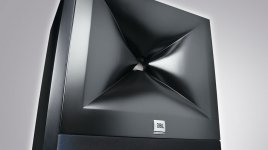I would tend to think the math required to design this one would boggle the mind.
___________________________________________________Rick..........
I highly doubt that there is any math behind this. They probably used some BEM software and just crunched out some shapes.
Now this is what amuses me. Transitioning from one plane to another via the shortest and smoothest radius possible is expected of any tradesman for reasons of economy and grace. Deviation from this route would seem superfluous and wasteful. I see this as a given. Arggghhh.
Hindsight makes everyone brilliant.
Sorry, I feel we have all gotten carried away with this horn thing
If you listen to horns much you would realize that there are vast differences in the way that they sound - so its not an inconsequential discussion. Horns can be great, even ideal and they can be terrible and it's all a matter of the details that you find irrelevant.
And its "Feynman". He would not have found these discussions irrelevant.
Keep wondering if something like a SEOS 24 modofoed to accept mids as a quick n easy synergy horn would be of any merit?
You are confusing Elliptic Cylindrical (EC) with Ellipsoidal.
I am not confusing anything. Your words today just don't match your words in the past.
I agree with what you said in the past, but not what you are saying now.
Of the three elliptical coordinate systems, I find round OS horns to be less attactive than those made from the other two (PS and EC), because the other elliptical coordinate systems provide much more versatility. But I do like having an OS throat blended into a PS or EC nearer to the mouth.
I spent a couple hours trying to make one of those in Autodesk Design 3D, with little success 🙁
-picture it without the hole - as if it extend to the center in the same shape.
It's two sets of weird "triangles". Essentially you want to "cut" the triangles in half - making half of one.
Start with the profile/contour for the *center* of one triangle (its plane), then
(Note: make sure that all triangle profile/contours *start* as if from the center of the waveguide - like the hole isn't there.)
Make the profile/contour for the creased "edge" (its plane relative to the first), then
Use the loft function to connect the two profile/contour "slices", then
Use the mirror function to mirror over the other half of the "triangle", then
Copy that new "triangle" and invert it to the opposite side and move it into position.
From there all you should need is the profile/contour of center of the next other set of triangles - and you can loft that to each "crease" on that side of the triangle you've already created. And again new triangle: copy and correctly place relative to the other triangles.
Once that's done all you need to do is create your center hole diameter as an extrude cut and your done.
The toughest part is getting the spline/line for the contour the way you want it, but there are really only 3 of them: 2 different centers contours (similar, yet one is longer than the other), and one crease contour.
Attachments
Last edited:
It's two sets of weird "triangles". Essentially you want to "cut" the triangles in half - making half of one.
😉
Attachments
Yes, the 4 "triangles".
Please excuse my poor paint skills.. 😱
Rather (on what to do in the cad),
"A" represents the contour of the center of the top and bottom "triangle".
"B" represents the contour of the outer-edge of the triangle or "crease".
The double arrows points to the two outline "slices" you want to use the loft function on.
Both are "cut-away" representations, as if you cut a very fine slice through the top of the waveguide (cutting downward) and looked at that cut on it's side. (..and I'm assuming a relative "box"/right-angle shape for everything but the waveguide's contour/flair.)
Both have their own planes and are relative to each other. It's really a 2D outline/sketch on that plane, and then lofting one sketch to the other.
It's probably best to start with some guide-lines for the center (top-down perspective) to get the placement and angle right for each plane to draw your "slice" on.
Attachments
Last edited:
Yes, the 4 "triangles".
I see it like two curves
its like an orchid, really
and doing double duty also being a phase plug at the same time
Attachments
OK, you disagree, except that your interpretation of what I said in the past is wrong and what I am saying now is correct.I agree with what you said in the past, but not what you are saying now.
Really, where did you go to school? At Penn State they did not use Morse and Feshbach when I went there and U of M did not use them either. People might buy them but as course texts they were pretty intimidating.
That's the difference between Penn State and Penn. I give a lot of grief to one of my researchers who got his doctorate at Drexel, so I'm an equal opportunity snob. 😀
My undergrad (which was when I took math methods) was at UMBC. Kathleen Turner and I graduated together, my brush with fame.
You used Morse and Feshbach "Methods of Theoretical Physics" as an undergrad!!? I really do find that difficult to believe. That is not an undergrad level of math. Are we talking about the same books? Those texts were written by Feshbach from Morse's notes for his graduate physics math classes at MIT. So even there it was a graduate level text and Morse was renowned for his mathematical prowess. He was Feynman's advisor.
Yes, we did. It was a tough curriculum- at the time, UMBC's philosophy was to teach to the same rigor as MIT, Harvard, CalTech and accept a high attrition rate (in the sciences, it was over 80%). Our acceptance rate into Johns Hopkins med school was higher than Johns Hopkins undergrads, and I was accepted with full scholarship and teaching fellowship to every grad school I applied to. And I was pretty good, but hardly the best of the lot- the top physics major was the guy who played guitar in our band, and he ended up graduating summa cum laude and doing a physics PhD at Stanford (again, full ride). He's had a spectacular career in NLO and, later, information science. And he's still the best guitarist I've ever played with.
If you listen to horns much you would realize that there are vast differences in the way that they sound - so its not an inconsequential discussion. Horns can be great, even ideal and they can be terrible and it's all a matter of the details that you find irrelevant.
And its "Feynman". He would not have found these discussions irrelevant.
Thanks for your correction on Feynman spelling. I have no concern with the physics. You have helped illuminate the path of horn developments with the math. But as you say, the math modeliing can now be much simpler, assisting currentdesigners who want to model for their own complete designs with currently available drivers.
What this thread has been dealing with is also the practical options for the Ariel replacement. And this requires to be evolved to a stable Mk 1 that we DIYers would be happy carry out as a speaker project.
Lynn is making progress here but I am not sure we can sit down and write a list of items to buy.
I am aware that horns can produce imagery that belies belief, whether it reconstucts the recording venue ambience or has its own ambience with the pseudo 3D imagery.
Having heard what a short horn on a direct driver with my SET amp I am impressed. Some of us would like a half way house of short horn with say a sensitive 1" tweeter. This can possibly give the best of both worlds and probably a lot cheaper. I am not going to name which drivers.
I will follow Lynn s progress and any issues on the way. Hopefully I can be constructing something this fall.
Thanks for your useful recent iinsights and input. I know it is a very competitive arena and the snake oil syndrome easily gets in the way.
OK, you disagree, except that your interpretation of what I said in the past is wrong and what I am saying now is correct.
No, Earl, I'm not going to let you obfuscate this one.
You have discussed using PS and EC sections following OS sections many times in the past, and your patent letters describe same. I personally find this approach much better than a simple OS flare, and the use of these shapes is common in other engineering disciplines too, for the same reason.
The compression driver itself has to use a phase plug to create a plane wave, or something that approximates one. Then the wavefront is nudged into a curved shape that approximates a spherical section by the initial OS transition in the throat.
The bell of the horn may continue as a OS shape, closely resembling a conical flare, or it may continue as PS or EC sections, which also resemble a conical flare. There is very little difference after the intial throat section - in each of these waveguides (OS, PS or EC) - the horn is basically straight-walled.
After the straight-walled body of the waveguide/horn, the wavefront emerges at the mouth, another transition to freespace, or more often to the baffle boundary. Only then is it radiating into freespace.
So I dismiss your statement here, saying essentially that the OS shape is somehow "pure" and fundamentally different than the PS and EC shapes, which are all actually expressed using the exact same formula. I remind you that you yourself described the other shapes as "quite reasonable to assume that a gradual transition from the normal round outlet of a compression driver or speaker to the square section of the EC Waveguide would function without undue degradation of the devices performance, so long as the same cross sectional areas are maintained or grow at a slow rate."
No need for interpretation. You have stated the EC and PS shapes would function without undue degradation of the devices performance. You can change your mind, as you often do, but you can't claim what you said in the past was misinterpreted.
Nonsense
Nonsense
Because of my early interest in acoustics, the work of Morse, as well as others, was made known to me my by my high school physics/math teacher. To suggest that this work is obscure to those that have a serious interest in acoustics is utter nonsense.
Right now, the use of shape optimization technology [1] looks like a superior approach to horn design than just the rigorous application of tensor analysis alone.
Even Einstein had difficulty getting his head around the mathematical discipline required by tensors. [2] NB, At the time, he was still a young man.
Regards,
WHG
References:
[1] http://www.diyaudio.com/forums/multi-way/178566-uppsala-gets-better.html
[2] “I admire the elegance of your” [3] “method of computation; it must be nice to ride through these fields upon the horse of true mathematics while the like of us have to make our way laboriously on foot.” —Albert Einstein,
[3] Einstein was introduced to tensors by the geometer and friend, Marcel Grossman. Subsequently, during the period 1915 to 1917, Tullio Levi-Civita, well known for his work on tensor calculus, corresponded with Einstein to address mistakes Einstein had made in applying this analysis regime to his work on Relativity Theory.
I don't know anyone else in audio who has these texts. That seems obscure to me.
You can also get the set used on Amazon for a good price. I bought a pristine copy of Morse Vibration and Sound for about $20 on Amazon. And it even turned out to be a first addition.
As much as I enjoyed these texts when I was in school I would not recommend them to a physics student today. The modern approach to physics using tensors, etc. is so much more elegant. This was only lightly touched on by Morse, but is now the established basis of modern Physics and space-time. Maxwell's equations become a single simple one term equation like Einstein's tensor equation for gravity.
To me, the next breakthrough in "horn theory" will be when someone formulates the problem in tensor form. That would allow for a huge step in understanding with an appropriate simplification of the equations. To do the problem now in three separate orthogonal coordinates is a major PITA. With a tensor formulation and a modern computer the ideal waveguide for any arbitrarily specified input and output could readily be obtained with simple numerical procedures. Like Einstein, who saw the future of physics (as discrete rather than continuous) late in life but was too old to actually pursue it because the math was too hard, I too will have to wait for someone else to carry this torch.
Nonsense
Because of my early interest in acoustics, the work of Morse, as well as others, was made known to me my by my high school physics/math teacher. To suggest that this work is obscure to those that have a serious interest in acoustics is utter nonsense.
Right now, the use of shape optimization technology [1] looks like a superior approach to horn design than just the rigorous application of tensor analysis alone.
Even Einstein had difficulty getting his head around the mathematical discipline required by tensors. [2] NB, At the time, he was still a young man.
Regards,
WHG
References:
[1] http://www.diyaudio.com/forums/multi-way/178566-uppsala-gets-better.html
[2] “I admire the elegance of your” [3] “method of computation; it must be nice to ride through these fields upon the horse of true mathematics while the like of us have to make our way laboriously on foot.” —Albert Einstein,
[3] Einstein was introduced to tensors by the geometer and friend, Marcel Grossman. Subsequently, during the period 1915 to 1917, Tullio Levi-Civita, well known for his work on tensor calculus, corresponded with Einstein to address mistakes Einstein had made in applying this analysis regime to his work on Relativity Theory.
Last edited:
Nonsense
Because of my early interest in acoustics, the work of Morse, as well as others, was made known to me my by my high school physics/math teacher. To suggest that this work is obscure to those that have a serious interest in acoustics is utter nonsense.
Right now, the use of shape optimization technology [1] looks like a superior approach to horn design than just the rigorous application of tensor analysis alone.
Even Einstein had difficulty getting his head around the mathematical discipline required by tensors. [2] NB, At the time, he was still a young man.
Regards,
WHG
References:
[1] http://www.diyaudio.com/forums/multi-way/178566-uppsala-gets-better.html
[2] “I admire the elegance of your” [3] “method of computation; it must be nice to ride through these fields upon the horse of true mathematics while the like of us have to make our way laboriously on foot.” —Albert Einstein,
[3] Einstein was introduced to tensors by the geometer and friend, Marcel Grossman. Subsequently, during the period 1915 to 1917, Tullio Levi-Civita, well known for his work on tensor calculus, corresponded with Einstein to address mistakes Einstein had made in applying this analysis regime to his work on Relativity Theory.
Interesting, I've never seen [1]
Here's a PDF with some 'light reading' that's related:
http://www.comsol.com/model/download/65700/models.aco.horn_shape_optimization.pdf
"This model shows how to apply boundary shape optimization to a simple axisymmetric horn. For the sake of simplicity, the far-field sound pressure level is maximized for a single frequency and in a single direction. The focus is on the optimization procedure, which involves parametrization of the geometry, choice of objective function and optimization solver settings. The model was inspired by the work of Erik Bängtsson, Daniel Noreland, and Martin
Berggren"
Yes, we did. It was a tough curriculum- at the time, UMBC's philosophy was to teach to the same rigor as MIT, Harvard, CalTech and accept a high attrition rate (in the sciences, it was over 80%). Our acceptance rate into Johns Hopkins med school was higher than Johns Hopkins undergrads, and I was accepted with full scholarship and teaching fellowship to every grad school I applied to. And I was pretty good, but hardly the best of the lot- the top physics major was the guy who played guitar in our band, and he ended up graduating summa cum laude and doing a physics PhD at Stanford (again, full ride). He's had a spectacular career in NLO and, later, information science. And he's still the best guitarist I've ever played with.
One of the biggest mistakes I made in college was getting a D in trig. A good grasp on trig is essential for physics, and though I don't think that two years of physics classes are a prerequisite to be a software developer, the California State University system did not agree with me.
Hence, I dropped out of college and spent my time learning how to write software, not how to calculate vectors.
So all of this math is way over my head.
Here's some things I have observed as a layman:
1) There is no perfect horn. Some horns are optimized for certain variables. For instance, the oblate spheroidal curve puts constant directivity ahead of other variables.
2) The whole reason I started this thread was when I noticed that the shape of the throat and the shape of the mouth termination on an OS waveguide affected the directivity. I found this by studying wavefront formation in hornresp's wavefront simulator.
Again, as a layman it appears to me that you can't have your cake and eat it too. You can optimize for directivity, but if you do, the frequency response and the group delay will suffer. You can fix the frequency response with EQ, but you cannot fix the group delay.
Conversely, you can optimize for group delay and frequency response. If you do that, it will likely look a lot like a LeCleach horn or a spherical horn. But when you do that, the directivity suffers.
JBL seems to 'get this'; most of their horns from the last 10-15 years seem to fall on a spectrum between the two curves. They're not as large and as deep as the LeCleach, but they're not straight sided like the OS curve.
You could literally have an infinite number of horn profiles, and everyone can argue that their horn profile is superior. But beauty is in the eye of the beholder, and one user may prize directivity over group delay, while another user may prize group delay over directivity. A third may prize a blend of both.
None of them are right; and there is no curve that offers 100% of both.
No, Earl, I'm not going to let you obfuscate this one.
You have discussed using PS and EC sections following OS sections many times in the past, and your patent letters describe same.
I have never said that and I will not be dragged into another pointless argument with you.
You can go tell on me to the moderators now.

I have never said that and I will not be dragged into another pointless argument with you.
So what were you and I discussing at the GPAF in Tulsa then? What were you proposing for an asymmetrical horn using an elliptical coordinate system?
It's a rhetorical question, as I remember the discussion. You suggested a prolate spheroidal bell section following an oblate spheroidal throat. We also discussed the elliptic cyllindrical variant, basically the same thing.
Same rhetorical question - What is it that you applied for patent on several years later? The patent I linked earlier describes the very same thing.
- Status
- Not open for further replies.
- Home
- Loudspeakers
- Multi-Way
- Are Most Horns Fundamentally Flawed?





